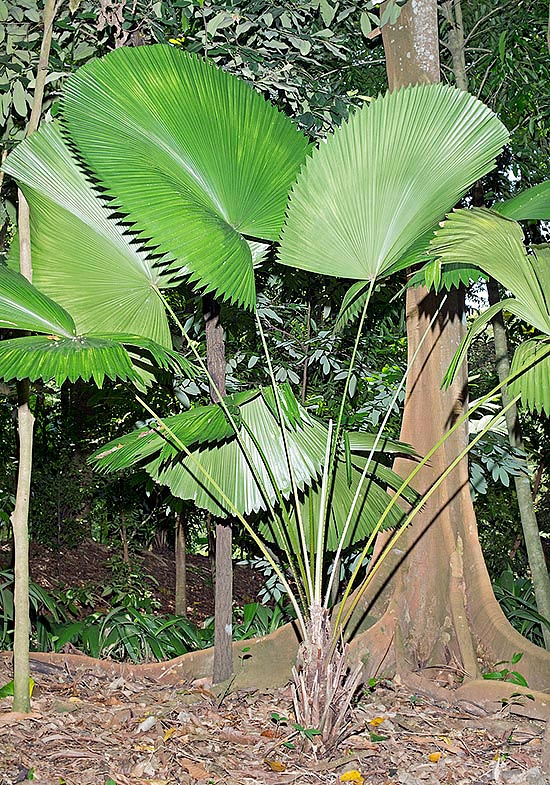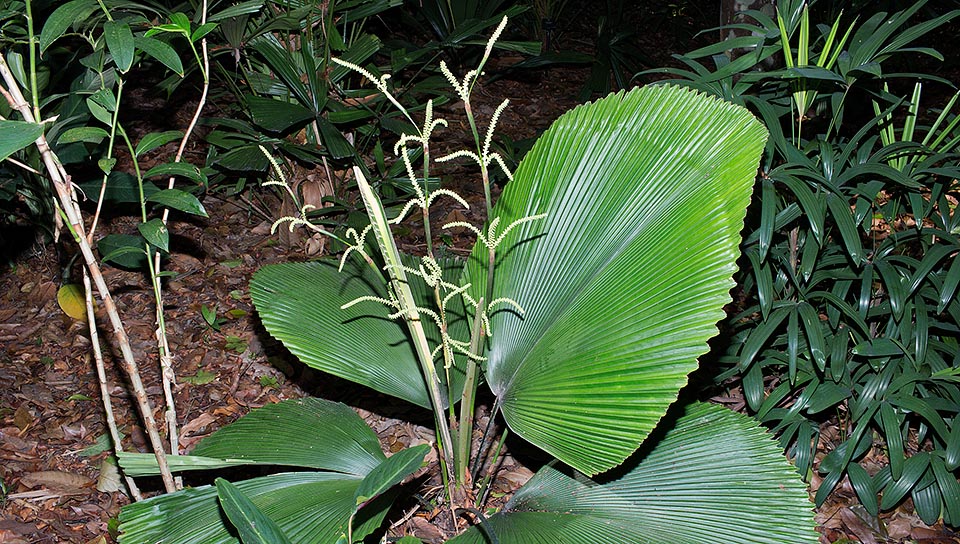Family : Arecaceae

Text © Pietro Puccio

English translation by Mario Beltramini

Native to Borneo, Licuala orbicularis is one of the most spectacular palms with about 1 m round leaves, carried by a 1,5 m long thin petiole. The stem is underground or just emerging © Mazza
The species is native to Borneo (sub-western Sarawak), where it grows in the underwood of the pluvial forests from the sea level up to about 500 m of altitude.
The generic name comes from the local name “leko wala” given to this genus of palms in the Molucca Islands; the specific name is the Latin adjective “orbicularis” = circular, with reference to the shape of the leaf.
Common names: parasol palm (English); palmier parasol (French); biris, biru balat, biru bulat, biru ruai, berupat (Sarawak); daun nisang, gereneh (Singapore).
The Licuala orbicularis Becc. (1889) is a slow-growing solitary monoecious species with thin underground or just emerging stem. The leaves, on thin petiole provided of sparse thorns of length decreasing towards the apex, up to about 1,5 long in the adult plants, are palmate, undivided, almost circular and flat, about 1 m broad, plicate with slightly waved and toothed margins, coriaceous, of glossy intense green colour. Inflorescences between the leaves (interfoliar) initially erect, then curved when in fruit, up to about 1 m long, with whitish hermaphroditic flowers spirally arranged. The fruits are globose, of 1,2 cm of diametre, red when ripe.
It reproduces by seeds, previously cleaned from the pulp and kept in lukewarm water for two days, in aerated and organic loam maintained humid at the temperature of 25-28 °C, with germination times that may vary from some months to one year.
One of the most spectacular palms in absolute, but quite rare in cultivation due to the poor availability of seeds and for its particular cultivation exigencies, cultivable in open air exclusively in the tropical and marginally subtropical climate zones characterized by high temperatures, not under 22 °C for a better growth, and humidity.
It requires a semi-shaded to shaded position, sheltered from the winds, and soils rich of organic substance, well drained, slightly acidic, maintained constantly humid. Elsewhere, it can be cultivated in pot for the decoration of greenhouses and winter gardens, utilizing non-calcareous water for the waterings and with periodical fertilizations with a balanced product, with microelements under form of chelates, at half the dosage suggested in the package. For the inner spaces decoration, the main obstacle is the insufficient humidity, this may be tried to be increased with frequent nebulizations with rainwater, or by reverse osmosis, at ambient temperature, and placing the plant on a wide flowerpot saucer full of expanded clay and partially of water, in way that the bottom of the pot is not in contact with this, in order to create a humid microclimate.

Inflorescences between the leaves, initially erect, then curved when in fruit, up to about 1 m long, with whitish hermaphroditic flowers spirally arranged © G. Mazza
Synonyms : Pritchardia grandis H.J.Veitch (1885); Licuala veitchii W.Watson ex Hook.f. (1889).
→ For general notions about ARECACEAE please click here.
